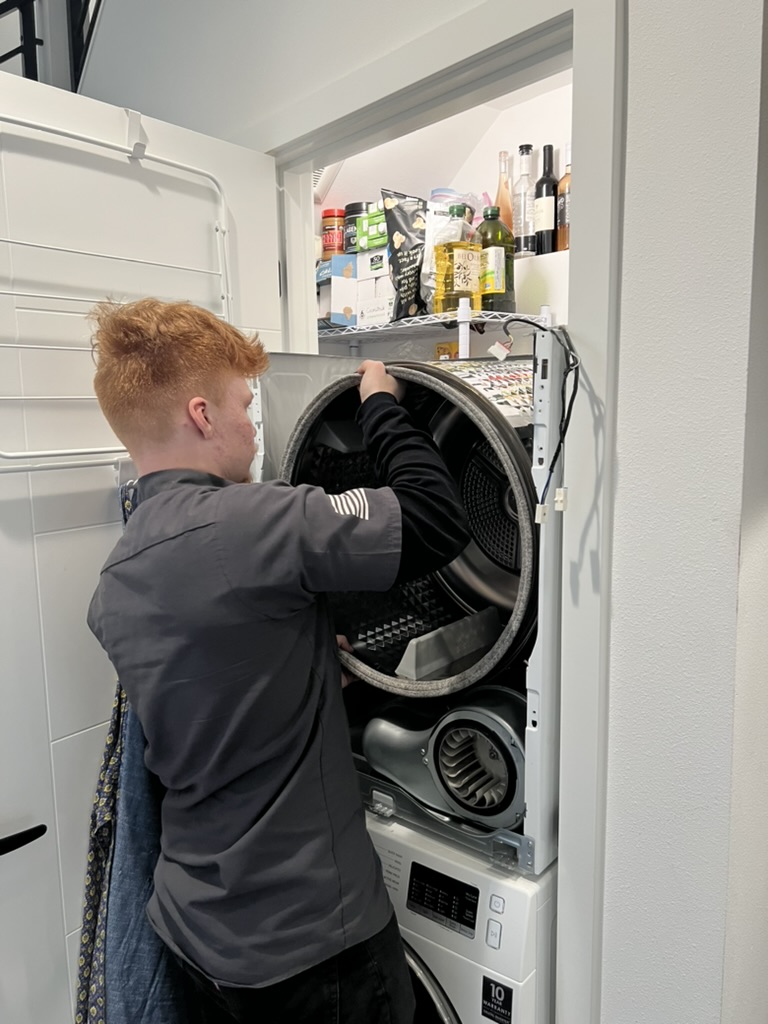Washer or dryer not working? Don’t stress! We’ll get your laundry back on track!
With same-day service availability, certified specialists, and a commitment to quality repairs, we ensure your appliances work like new again. No surprises — just expert service with honest pricing.


At EHS, we understand how essential your laundry appliances are and how much trouble a broken washing machine or dryer could cause. However, backed by 10 years of experience in washer and dryer repair service, we know how to quickly settle laundry issues and avert more serious problems. With us, you’ll say goodbye to laundry delays and hello to laundry machines operating like a charm.
Professionalism you can trust: Whether it’s a leaking washer, a dryer that won’t start, or a machine making strange noises, we have extensive practical expertise and professional knowledge to diagnose and resolve the issue efficiently.
Qualified specialists: With years of hands-on experience, our certified washer technicians stay ahead of the latest technology and repair techniques, providing long-lasting solutions that restore your appliances to peak performance.
Advanced tech experience: Modern washers and dryers come with sophisticated digital controls, smart sensors, and energy-efficient technology. Our experts can handle everything from traditional mechanical issues to complex electronic malfunctions.
Comprehensive service: Whatever happens to your laundry machines, we know how to fix them. No matter the problem, we’ll restore their functionality and ensure they will serve you for years to come.
Posted onTrustindex verifies that the original source of the review is Google. Thomas is a very friendly and knowledgeable technician. He communicated with us well and scheduling was very timely. He fixed our double ovens for us and repaired an exhaust problem with our range. We highly recommend Thomas to anyone needing appliance repair! 5 stars!Posted onTrustindex verifies that the original source of the review is Google. Service was scheduled quickly, repairman called with expected arrival time and arrived promptly. Repairs needed were identified and carried out, kitchen was left clean and the refrigerator works! He called the next day to be sure everything was working well. This was an excellent experience throughout.Posted onTrustindex verifies that the original source of the review is Google. Dmitro was amazing! He showed promptly when he said he would, explained all my options thoroughly when it came to addressing the obnoxious noises my fridge was making, and had an impressive eye for detail (he managed to empty and then re-place everything in my fridge almost exactly where he had found it! Impressive!) he was kind and easy to work worth.Posted onTrustindex verifies that the original source of the review is Google. Vlad was very helpful, timely, and communicative. He was able to quickly conduct diagnostics, ordered the necessary part, and my washing machine was back up and running within a few days. Thanks Vlad!Posted onTrustindex verifies that the original source of the review is Google. Great costumer service was able to set up an appointment for a technician to come look at a problem with refrigerator on a next day! Dmitro, the technician, was able to determine an issue with the ice maker in our Bosh 800 series refrigerator. He recommended to replace parts. Ordered them right away and installed on a next visit. It is working perfectly since, making ice again. Thanks! I highly recommend this company to anyone who is looking for a fast, professional solutions.Posted onTrustindex verifies that the original source of the review is Google. We got excellent service from Demitro. He is very knowledgeable and repaired the service to our dishwasher in one visit. I have their number on speed dial and will be recommending their services to friends and family. MPosted onTrustindex verifies that the original source of the review is Google. I was so impressed with Expert Appliance Repair and especially Dmitro. I have used this company before for some refrigerator maintenance and they were awesome then as well. I think what impresses me most is how quickly they respond. Dmitro was professional,polite and personable. He looked at the problem I was having and ordered the parts to be overnighted. He came back the following day, installed the parts efficiently checking to make sure the parts were in correctly and working properly. The parts and repair were very reasonable. I will always use this company for appliance repair and will share their number with my neighbors and friends.Posted onTrustindex verifies that the original source of the review is Google. We had an excellent experience with Leo who repaired our Sub-Zero refrigerator. The service was fast, professional, and efficient. He responded quickly to our request, diagnosed the issue right away, and had it fixed promptly. The pricing was very reasonable, especially considering the quality of the work. Highly recommend for anyone in need of reliable appliance repair!Posted onTrustindex verifies that the original source of the review is Google. EAR was prompt in responding to our leaky washing machine. Dimitro came and diagnosed the issue, a leaking drain hose. He helped me in finding the correct part on a reliable website. I ordered the part and he returned to fix it. I was very impressed with Dimitro and EAR’s performance, and the way they handled the problem professionally. And the whole job was reasonably priced. I would definitely recommend EAR for your appliance repairs since these guys are experts in what they do.
We accept online service requests 24/7. Requests sent during business hours are processed promptly. After-hours requests will be handled the next morning.


